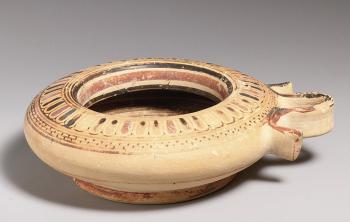American Journal of Archaeology | The Journal of the Archaeological Institute of America
You are here
Shedding Light on the Kothon: Vases with Inward Downturned Rims Revisited
April 2021 (125.2)
Shedding Light on the Kothon: Vases with Inward Downturned Rims Revisited
A particular type of ancient Greek vessel has a distinctive inward and downturned rim that forms an interior hollow ring. Because of the unique rim formation, various proposals have been suggested as to the purpose and name of this vessel, including a cup (kothon), an incense burner (thymiaterion), an ointment box (smegmatotheke), a ritual vase for the Eleusinian Mysteries (plemochoe), a floating-wick lamp (stilbe), and the currently prevailing identification as a perfume pot (exaleiptron). It is my opinion that only the identification of the shape as a lamp fully explains the strongly inturned rim. In this contribution, I revisit the material record, addressing issues of form, function, and decoration, as well as relevant representations in vase painting, in an effort to better understand the use of this particular vessel.
Shedding Light on the Kothon: Vases with Inward Downturned Rims Revisited
By Dorina Moullou
American Journal of Archaeology Vol. 125, No. 2 (April 2021), pp. 183–206
DOI: 10.3764/aja.125.2.0183
© 2021 Archaeological Institute of America


